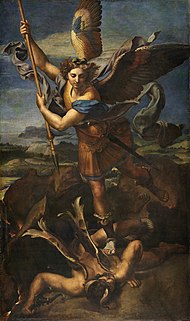
Leonardo di ser Piero da Vinci was an Italian polymath of the High Renaissance who was active as a painter, draughtsman, engineer, scientist, theorist, sculptor, and architect. While his fame initially rested on his achievements as a painter, he has also become known for his notebooks, in which he made drawings and notes on a variety of subjects, including anatomy, astronomy, botany, cartography, painting, and palaeontology. Leonardo is widely regarded to have been a genius who epitomised the Renaissance humanist ideal, and his collective works comprise a contribution to later generations of artists matched only by that of his younger contemporary Michelangelo.

Michelangelo di Lodovico Buonarroti Simoni, known mononymously as Michelangelo, was an Italian sculptor, painter, architect, and poet of the High Renaissance. Born in the Republic of Florence, his work was inspired by models from classical antiquity and had a lasting influence on Western art. Michelangelo's creative abilities and mastery in a range of artistic arenas define him as an archetypal Renaissance man, along with his rival and elder contemporary, Leonardo da Vinci. Given the sheer volume of surviving correspondence, sketches, and reminiscences, Michelangelo is one of the best-documented artists of the 16th century. He was lauded by contemporary biographers as the most accomplished artist of his era.

Raffaello Sanzio da Urbino, now generally known in English as Raphael, was an Italian painter and architect of the High Renaissance. His work is admired for its clarity of form, ease of composition, and visual achievement of the Neoplatonic ideal of human grandeur. Together with Leonardo da Vinci and Michelangelo, he forms the traditional trinity of great masters of that period.

The Uffizi Gallery is a prominent art museum located adjacent to the Piazza della Signoria in the Historic Centre of Florence in the region of Tuscany, Italy. One of the most important Italian museums and the most visited, it is also one of the largest and best-known in the world and holds a collection of priceless works, particularly from the period of the Italian Renaissance.

Giorgio Vasari was an Italian Renaissance painter, architect, art historian and biographer, who is best known for his work Lives of the Most Excellent Painters, Sculptors, and Architects, considered the ideological foundation of all art-historical writing, and still much cited in modern biographies of the many Italian Renaissance artists he covers, including Leonardo da Vinci and Michelangelo, although he is now regarded as including many factual errors, especially when covering artists from before he was born.

Renaissance art is the painting, sculpture, and decorative arts of the period of European history known as the Renaissance, which emerged as a distinct style in Italy in about AD 1400, in parallel with developments which occurred in philosophy, literature, music, science, and technology. Renaissance art took as its foundation the art of Classical antiquity, perceived as the noblest of ancient traditions, but transformed that tradition by absorbing recent developments in the art of Northern Europe and by applying contemporary scientific knowledge. Along with Renaissance humanist philosophy, it spread throughout Europe, affecting both artists and their patrons with the development of new techniques and new artistic sensibilities. For art historians, Renaissance art marks the transition of Europe from the medieval period to the Early Modern age.
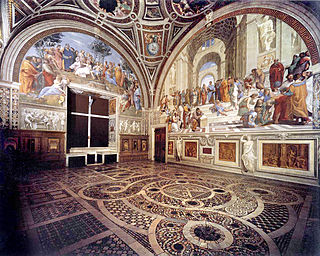
In art history, the High Renaissance was a short period of the most exceptional artistic production in the Italian states, particularly Rome, capital of the Papal States, and in Florence, during the Italian Renaissance. Most art historians state that the High Renaissance started between 1490 and 1500, and ended in 1520 with the death of Raphael, although some say the High Renaissance ended about 1525, or in 1527 with the Sack of Rome by the mutinous army of Charles V, Holy Roman Emperor, or about 1530. The best-known exponents of painting, sculpture and architecture of the High Renaissance include Leonardo da Vinci, Michelangelo, Raphael, and Bramante. In the 21st century, the use of the term has been frequently criticized by some academic art historians for oversimplifying artistic developments, ignoring historical context, and focusing only on a few iconic works.

Museo di Capodimonte is an art museum located in the Palace of Capodimonte, a grand Bourbon palazzo in Naples, Italy designed by Giovanni Antonio Medrano. The museum is the prime repository of Neapolitan painting and decorative art, with several important works from other Italian schools of painting, and some important ancient Roman sculptures. It is one of the largest museums in Italy. The museum was inaugurated in 1957.
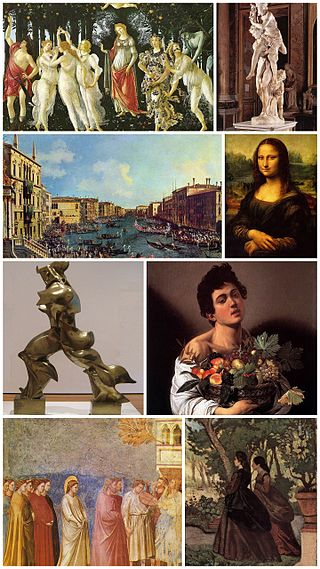
The cultural and artistic events of Italy during the period 1500 to 1599 are collectively referred to as the Cinquecento, from the Italian for the number 500, in turn from millecinquecento, which is Italian for the year 1500. Cinquecento encompasses the styles and events of the High Italian Renaissance, and Mannerism.

The Madonna del cardellino or Madonna of the Goldfinch is an oil on wood painting by the Italian Renaissance artist Raphael, from c. 1505–1506. A 10-year restoration process was completed in 2008, after which the painting was returned to its home at the Uffizi in Florence. During the restoration, an antique copy replaced the painting in the gallery.
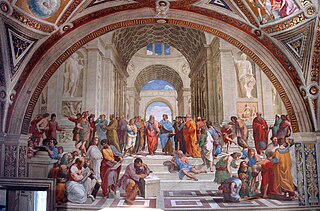
Pope Julius II, commissioned a series of highly influential art and architecture projects in the Vatican. The painting of the Sistine Chapel ceiling by Michelangelo and of various rooms by Raphael in the Apostolic Palace are considered among the masterworks that mark the High Renaissance in Rome. His decision to rebuild St Peter's led to the construction of the present basilica.

Florentine painting or the Florentine school refers to artists in, from, or influenced by the naturalistic style developed in Florence in the 14th century, largely through the efforts of Giotto di Bondone, and in the 15th century the leading school of Western painting. Some of the best known painters of the earlier Florentine School are Fra Angelico, Botticelli, Filippo Lippi, the Ghirlandaio family, Masolino, and Masaccio.

Italian Renaissance painting is the painting of the period beginning in the late 13th century and flourishing from the early 15th to late 16th centuries, occurring in the Italian Peninsula, which was at that time divided into many political states, some independent but others controlled by external powers. The painters of Renaissance Italy, although often attached to particular courts and with loyalties to particular towns, nonetheless wandered the length and breadth of Italy, often occupying a diplomatic status and disseminating artistic and philosophical ideas.

This article about the development of themes in Italian Renaissance painting is an extension to the article Italian Renaissance painting, for which it provides additional pictures with commentary. The works encompassed are from Giotto in the early 14th century to Michelangelo's Last Judgement of the 1530s.

The Madonna of the Magnificat, is a painting of circular or tondo form by the Italian Renaissance painter Sandro Botticelli. It is also referred to as the Virgin and Child with Five Angels. In the tondo, we see the Virgin Mary writing the Magnificat with her right hand, with a pomegranate in her left, as two angels crown her with the Christ child on her lap. It is now in the galleries of the Uffizi, in Florence.
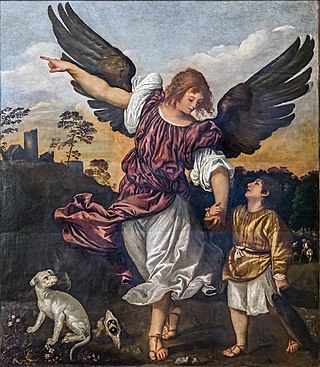
Tobias and the Angel is the traditional title of depictions in art of a passage from the Book of Tobit in which Tobias, son of Tobit, travels with the Archangel Raphael without realising he is an angel (5.5–6) and is then instructed by Raphael what to do with a giant fish he catches (6.2–9). The Book of Tobit is accepted by Catholic and Eastern Orthodox Christians as part of the biblical canon, but not by Judaism or most Protestant Christians, the latter including it in the Apocrypha.

The Musée Bonnat-Helleu is an art museum in Bayonne, Nouvelle-Aquitaine, France. The museum was created in 1901 when Bayonne-born painter Léon Bonnat gave his extensive personal collections of art – notably an exceptional drawing collection – as well as many of his paintings to the City of Bayonne. Subsequent donors enriched the collections of the Bonnat Museum with major gifts in 1936, 1989, 1997 and 2010, making its holdings one of the largest collections of art in southern France.
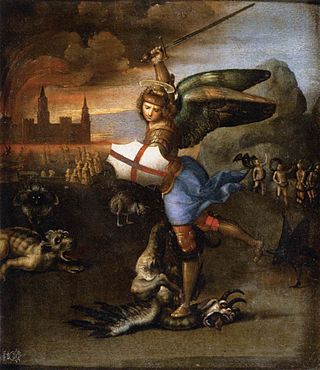
Saint Michael is an oil painting by the Italian artist Raphael. Also called the Little Saint Michael to distinguish it from a larger, later treatment of the same theme, Saint Michael Vanquishing Satan, it is now in the Louvre in Paris. The work depicts the Archangel Michael in combat with the demons of Hell, while the damned suffer behind him. Together with the Saint George, it represents the first of Raphael's works on martial subjects.
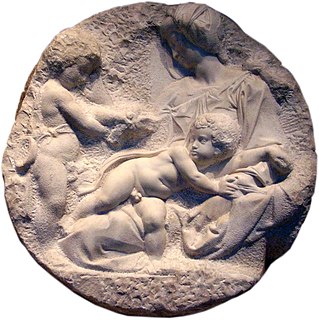
The Taddei Tondo or The Virgin and Child with the Infant St. John is an unfinished marble relief tondo of the Madonna and Child and the infant Saint John the Baptist, by the Italian Renaissance artist Michelangelo Buonarroti. It is in the permanent collection of the Royal Academy of Arts in London. The tondo is the only marble sculpture by Michelangelo in Great Britain. A "perfect demonstration" of his carving technique, the work delivers a "powerful emotional and narrative punch".
